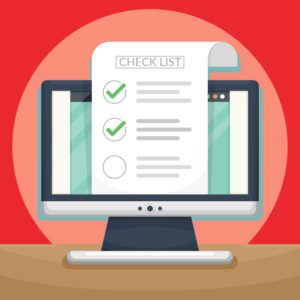 Recently, we’ve taken a deep dive into creating a winning value proposition and in crafting a compelling call to action. Now it’s time to talk testing.
Recently, we’ve taken a deep dive into creating a winning value proposition and in crafting a compelling call to action. Now it’s time to talk testing.
At the core of conversion optimization is the ability to run consistent, iterative tests. These tests allow you to consistently focus on specific elements of your website and improve them incrementally.
The most simplistic, yet useful, test that you can run is a split test. This is where you focus on one element of your web page and put what you have currently (the control) against an alternative (the variation).
Let’s get right to it with the seven website element split tests that will help you maximize conversions on your website.
Headline
One of the first elements that a visitor will see on your website is the headline of your page. Whether you’re selling a product or offering up content such as a blog, the headline is one of the first considerations someone sees to determine if they want to read on or bail.
There are many different styles you can take when writing a headline. You can make it humorous, hype-filled, exaggerated, fear-based, direct, or any combination. There’s no one right headline. So how do you figure out what works best?
Think about your website. Think about what you sell or offer. Try and match the headline to the distinct value you are showing the consumer. You can still make a headline compelling, or scary, or whatever you want, but make sure that at its core it aligns with what makes your product or service unique.
Navigation Bar
Another great element to test is the navigation bar on your website. The ease of navigation on your website can have a huge impact on overall conversions. If your messaging is convoluted or not in line with a customer’s expectations, you are going to lose them.
Think logically about what it is that you are trying to accomplish. Focus on the end goal. The main menus in your navigation should reflect this.
Aside from just the navigation menus, you should also think carefully about the search bar on your website. In most cases, this will appear within or alongside your navigation. Many retailers have not optimized their search bar for the user experience and end up missing out on huge conversion opportunities.
For instance, we noticed that one of our CRO clients saw much higher conversions from users who interacted with the search bar. To increase the number of users interacting with search, the team redesigned the search bar to make it more prominent – increasing the color contrast, changing the button icon, and using more descriptive placeholder text. This variation led to a 15.5% overall increase in conversion rate!
Body Copy
The text that appears on your product pages, landing pages, or even content/resource pages can also be very crucial to conversions. This is your chance to tell a compelling story about your product or service. It’s also an opportunity to refocus the attention onto the consumer.
Far too many companies get caught up in bragging about how great they are without realizing that customers don’t care. Customers want to know what’s in it for them.
Use this space as an opportunity to let your product sell itself. Talk about the features and benefits that are unique. Make the consumer feel like they are the hero in your copy. Make them compelled to learn more or make a purchase.
Copy Length
You’ve heard the expression “less is more”. Well, that’s not always true. Yes, in the era of millennials and cell phones the average attention span has taken a hit, but that doesn’t always mean that short text is the way to go.
You need to truly understand who is your target audience. What do they like, and what do they want to see? You also need to understand how your product or service fits into their lives. For instance, if you are offering life insurance, a couple paragraphs of copy explaining it isn’t going to cut it. You’ll want to go in-depth into the features and benefits that make your offering unique, and how it will positively impact your target audience.
Conversely, if you’re selling paper towels, you probably don’t need three pages of text explaining the benefits. You could write the most amazing copy and give a compelling story, but if a consumer just wants to make a quick purchase, it can actually negatively impact your conversions to oversell it. Once again, you must think like your customers and keep testing.
Call to Action
When thinking of your call to action, there are a few important questions to keep in mind:
- What is the Value?
- What is Your Goal?
- Where on the page will it have the greatest impact?
- What is the message that makes the most sense?
- How does it fit within the context of your page?
There are definitely other factors to consider, but if you can focus on these five questions as a starting point, you’ll have a much easier time coming up with compelling tests to optimize your CTA. For even more insights on how to optimize your CTA, take a look at last week’s blog which takes an in-depth look at strategies that convert.
Images
The images you use on your page can have a huge impact on your overall conversions. You’ve heard the expression “a picture is worth a thousand words”. This is especially true when trying to sell a product.
Consumers want to see what your product looks like, but they also want to see how it looks in a situation that they might find themselves in. For instance, if you’re a clothing retailer, you might want to consider more than a simple product photo on a white background.
Lifestyle photos, ie those which show the product being worn by an actual person in a real situation, have been proven to be more effective in selling products. On Instagram for example, photos with faces get 38% more likes, and user-generated lifestyle photos have a 4.5% higher conversion rate.
Images offer a perfect testing opportunity. Try out different angles, different image sizes, or go lifestyle vs. product image if it’s something you have yet to look into.
Page Layout
You might not think it, but the actual layout of elements on your page can have a big impact on your conversions. For instance, if you’ve got video content, but it’s buried deep on your page, you could see a huge boost in conversions by pushing it closer to the top of the page.
Think holistically about your pages. What are the elements that have the biggest impact? This is a perfect chance to use heat maps or scroll maps to see how often users are clicking on certain items, or how far they are scrolling on your page.
With this information, you can make more educated decisions on what to test in terms of layout. These tests will have a much bigger impact than just making assumptions without anything to back them up.
Tying it All Together
When considering what to test, it’s essential that you have a hypothesis about what you expect. Often, this hypothesis can be pulled directly from data you can see in Google Analytics or via testing technologies like Visual Website Optimizer or Hotjar.
However, sometimes it’s equally beneficial to test something based on a hunch. Perhaps you’ve seen something a competitor has tried, or just noticed a spot on your site that customers might be confused. These tests can be equally beneficial! Even if they don’t produce the huge conversion lift you are looking for, you can at least rule out that aspect in the future. Remember, not every test will beat the control.
The whole idea is to continually test, continually iterate and move forward.
To discover even more testing strategies, as well ways to optimize your calls to action and value proposition, grab our latest white paper: The Q4 Conversion Rate Challenge. This detailed report will uncover further strategies to optimize your website and improve conversions.



